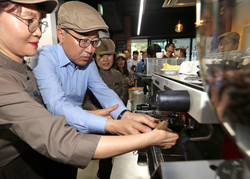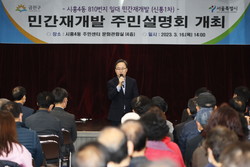The head of a district, which is the first affiliated organization established in Seoul, other metropolitan cities, and cities with a population of 500,000 or more, is the chief administrative officer. Rye Sung-hun, who graduated from the Department of Business Administration at Chung-Ang University (CAU), has been serving as the head of Geumcheon-gu, since 2018. He was the first to achieve the title, the first in the Korea and the first in Seoul several times, working for the residents more than anyone else. Let's find out Ryu Sung-hun, who is working hard to make Geumcheon-gu a happy place for everyone, in line with the slogan “Geumcheon-gu, the happy city all over neighborhoods.”
#Starting for Interview
1. Please introduce yourself for CAU students and readers of the Chung-Ang Herald.
Hello! I am Ryu Sung-hun, the head of Geumcheon-gu. I am very pleased to greet CAH readers and residents of Geumcheon-gu through the CAH magazine. After spending my school days in Geumcheon-gu, I graduated from the Department of Business Administration at CAU and completed my master's course at the Graduate School of Public Administration at Hanyang University. In addition, I have been working in politics for over 30 years, including as the Blue House administrator during the late President Kim Dae-jung, and the late Roh Moo-hyun administrations. Also, I was the general manager of the 18th presidential election commission. Since I ran for local elections in 2018 and took office as the 7th head of Geumcheon-gu, I have been the head of Geumcheon-gu.

2. What is the most memorable episode in attending CAU?
In school in the 1980s[1] student activities were suppressed. However, when I was in my senior year of CAU, the Student Union was reborn. Because of this, student council activities were also briskly carried out again, and I also participated a lot in it, so that moment is the most memorable.
3. What was the romance of CAU in the 1990s when you attended?
When I was at CAU, there was a large playground, and my friends and I talked about our dreams there. Also, I talked late at night on the lawn with my friends, and I came out of the classroom during class time and drank Makgeolli[2]. These memories are the most impressive.
4. You studied Public Administration in graduate school after graduating from the Department of Business Administration at CAU. Why did you choose Public Administration?
While doing political work, I have thought the most important thing is to make civilian’s lives happier and more convenient. For this, it is necessary to work with the residents. Therefore, in order to provide more systematic and logical welfare to the residents, I thought that I should study professionally about administrations. Because of this reason, I chose Public Administration.

#Life as Head of Geumcheon-gu Office
5.What are your future goals for making Geumcheon-gu an innovative city?
Currently, Geumcheon-gu is focusing on balanced regional development through urban infrastructure improvement. First, we are carrying out a maintenance project on the east side of Siheung-daero, where there is a concentration of old houses. In addition, Geumcheon-gu is currently expanding railroad facilities and improving the transportation system. The Shinansan Line double track will be completed in 2025. As such, I will continue to improve traffic conditions and strive for balanced regional development.

6. With the elderly population exceeding 9 million, what other specific plans is Geumcheon-gu currently making to provide quality jobs to the elderly?
As of 2025, Geumcheon-gu is expected to enter a super-aged society with a 20.3% elderly population. In order for the elderly to spend a healthy and high-quality old age, a variety of jobs that can not only help supplement income but also satisfy the desire to participate in society should be provided, so we are giving jobs for a total of 3,375 elderly people. In addition, various changes will be pursued in line with the increase in the number of ‘new’ seniors equipped with high education and expertise through employment placement projects.

7. What kind of solutions is Geumcheon-gu offering to those in the blind spot of welfare who are not receiving enough benefits, including beneficiary of national basic livelihood?
Geumcheon-gu promptly decides whether to provide emergency support for those who do not have a history of receiving welfare, and gives living expenses from 300,000 to 1 million won per month, depending on the number of household members. In addition, in order to respond to the risks of socially isolated households and strengthen care, the ‘With U Project’ is being promoted to process smart and human safety nets at the same time. Geumcheon-gu is also implementing the ‘Geumcheon Neighborhood Care SOS Service’ to address the care gap and provide customized welfare services for the vulnerable, such as the elderly and the disabled. In the future, by providing various solutions like this, we will promote a welfare policy to cover the blind spots.

8. Geumcheon-gu has the highest density of Chinese residents in Seoul following Yeongdeungpo/Guro-gu. What efforts are Geumcheon-gu making to coexist with multicultural families in the era of globalization?
The number of foreign residents in Geumcheon-gu accounts for 12.5% of the total population. Accordingly, Geumcheon-gu is promoting various policies for the stable settlement of foreign residents and multicultural families and to expand opportunities for social participation. The Geumcheon-gu Family Center is carrying out a multicultural family support project, and the Geumcheon Global Village Center is promoting a foreigner support project, operating a multicultural shelter for them, and implementing social integration support for Chinese-Koreans. Since the number of foreign residents is expected to increase in the future, I think we need to recognize them as community assets and move forward with establishing mutually beneficial relationships.

9. Geumcheon-gu has enhanced the effect of preventing accidents in alleyways through the artificial intelligence ‘Alley Life Safety Guard’, which detects pedestrians and informs the surroundings. In addition to this, what are other examples of ensuring traffic safety for residents through AI techonology?Geumcheon-gu builds smart services every year and introduces new pilot services to create a safe and smart walking environment for residents. The ‘Smart Alley Complex Solution Service’, which is being expanded every year, provides AI pedestrian, smart board, and runway-type crosswalk services. Geumcheon-gu is also paying great attention to the safety of children. For example, in order to prevent traffic accidents caused by children using smartphones while walking to and from school, bluetooth devices are installed some facilities which limit Internet use through a smartphone app. In addition, this year, Geumcheon-gu plans to test build an AIoT-based measurement device to detect the risk of ground subsidence issues such as sinkholes.

10. Geumcheon-gu is conducting various classes to foster talented human resources in the 4th industrial revolution. What are some possible ways to make local residents feel science in their daily lives?
Through the Geumcheon Science Cube, Geumcheon-gu is making efforts to strengthen the science and cultural capabilities of residents as well as students, and to continuously discover science resources in the district centered on G-Valley. Geumcheon Science Cube, which opened in 2021, provides various programs such as science lectures, performances, exhibitions, and experiences to local residents, and diversifies science education channels to operate programs to nurture scientific talents that meet the needs of our residents. By supporting science education programs not only for teenagers but for all ages, we are creating an environment where anyone can easily access and enjoy science and technology.

#Concluding the Interview
11. What is your biggest goal as a head of Geuncheon-gu Office?
Geumcheon-gu is my hometown, and since I grew up here, I know the difficulties of the residents better than anyone else, so I have a great desire for regional development. The biggest goal is to create a city where residents can live comfortably by improving the living environment, as well as large-scale regional development such as redevelopment and transportation infrastructure improvement. Another thing is that I have a goal to create a warm Geumcheon community, and I hope it will become a friendly city. Through innovation, Geumcheon-gu will no longer be the end of Seoul, but the beginning of it.

12. What does CAU mean to you as a politician and in your life?
CAU gave me the direction to go in my life. Like a compass, CAU taught me how to live for the future and how to move forward during my school life, and I am grateful for that.

13. Please give some advice and support to CAU students who are running hard towards their dreams.
Life in university is the starting point of a career where you have to carve out your own future as a member of society, so you may have a lot of worries and concerns about the future. I want CAU students to not be afraid of failure and set clear goals and plans in this process. Also, one more thing, I hope that students find their aptitude and individuality through the experience of society outside of school. “Do not be intimidated or discouraged by your outward appearance compared to others at this point. You have enough capacity and strength to carve out your own future.”
Through this interview, CAH was able to hear the story of Ryu Sung hun, the head of Geumcheon-gu Office, who is working tirelessly to help Geumcheon-gu to grow into a city of the future and to help the residents of Geumcheon-gu to live with great pride. After graduating from the Department of Business Administration at CAU, he is working hard for the development of Geumcheon-gu. CAH supports him as he aims to fundamentally improve the quality of life of Geumcheon-gu residents beyond only simple development of the region.

